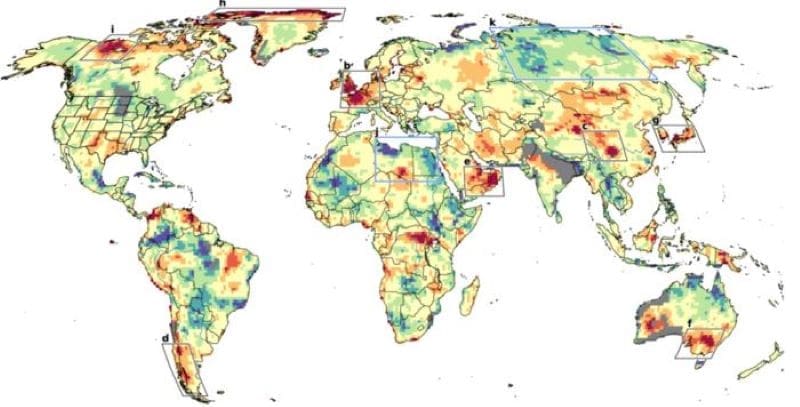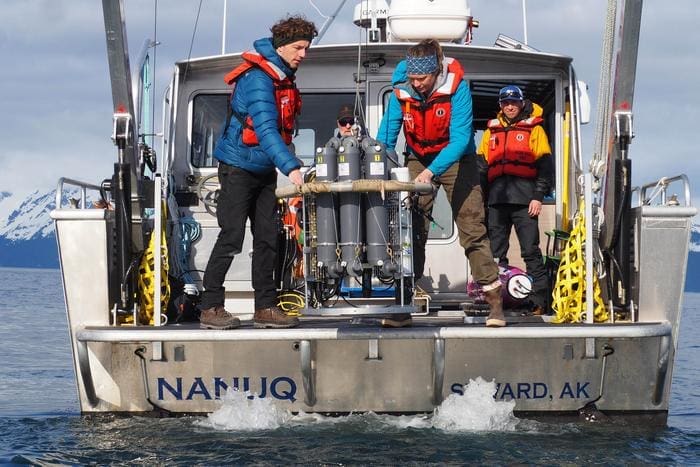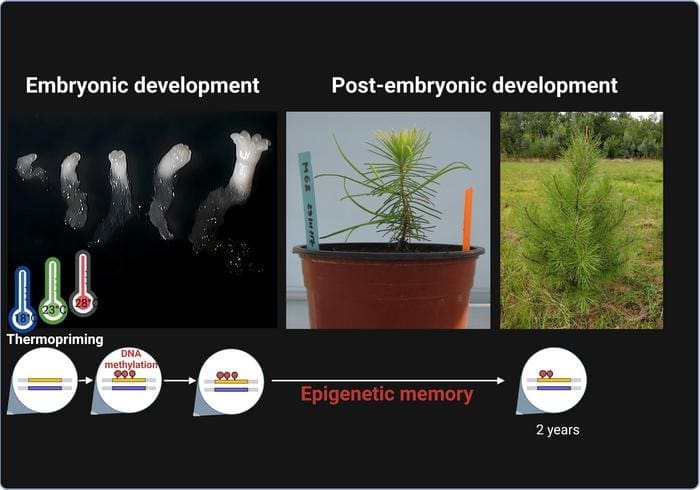Global heatwave hotspots defy climate models
The increasing severity and frequency of heatwaves worldwide have become a significant concern, with a recent study mapping global “hotspots” of these extreme events. These regions, spread across every continent except Antarctica, have experienced heatwaves that exceed predictions by existing climate models.
Such events have devastating impacts, including mass fatalities, extensive crop failures, and wildfires. For instance, the 2021 Pacific Northwest heatwave broke records by up to 30°C (54°F) and contributed to wildfires that destroyed the town of Lytton, British Columbia.

Northwestern Europe stands out as the most affected, with heatwaves in 2022 and 2023 causing tens of thousands of deaths (60,000 and 47,000, respectively) and new temperature records set as recently as September 2024.
Researchers describe this phenomenon as “tail-widening” – with extreme temperatures occurring more frequently than expected, contrasting with other regions where extreme heat increases align with predictions. Potential drivers include disruptions in the jet stream and the formation of Rossby waves, which funnel hot air to temperate regions. However, these mechanisms do not fully account for the anomalies.
Published in Proceedings of the National Academy of Sciences, the study warns of the growing gap between climate projections and real-world events, urging improvements in modeling to better predict regional climate risks. The findings underscore the pressing need for preparation, as excessive heat already claims more lives than hurricanes, tornadoes, and floods combined, with over 2,300 heat-related deaths recorded in the U.S. in 2023 alone.
Journal Reference:
K. Kornhuber, S. Bartusek, R. Seager, H.J. Schellnhuber, M. Ting, ‘Global emergence of regional heatwave hotspots outpaces climate model simulations’, Proceedings of the National Academy of Sciences 121 (49) e2411258121 (2024). DOI: 10.1073/pnas.2411258121
Article Source: Columbia Climate School
Seaglider advancements to monitor greenhouse gases in the ocean
The University of Alaska Fairbanks (UAF) has developed an innovative system to enhance greenhouse gas monitoring in oceans, equipping Seagliders with specialized sensors to track carbon dioxide (CO2) and methane levels. These unmanned underwater vehicles now provide high-resolution data critical for understanding how oceans absorb CO2, a process that has mitigated climate change but also led to harmful acidification.
The study, published in Ocean Science, highlights the technical breakthroughs required to integrate the bulky sensors into Seagliders, including adjustments to buoyancy using 3D-printed components.

Oceans have absorbed nearly one-third of anthropogenic CO2 since the industrial era, but this has lowered pH levels, threatening marine organisms and ecosystems.
The upgraded Seaglider system allows extended data collection in extreme environments, such as Alaska’s coastal waters, where warming temperatures destabilize methane hydrates trapped in subsea permafrost. These releases may amplify climate warming and trigger localized acidification events.
Expanding this technology, the UAF team is testing methane sensors to better understand emissions from ocean floors and their interaction with atmospheric greenhouse gases.
With Alaska’s challenging conditions in mind, researchers aim to adapt Seagliders for harsher environments, advancing global understanding of oceanic chemical processes. The insights gained are vital for designing effective climate adaptation strategies.
Journal Reference:
Claudine Hauri, Brita Irving, Dan Hayes, Ehsan Abdi, Jöran Kemme, Nadja Kinski, and Andrew M. P. McDonnell, ‘Expanding seawater carbon dioxide and methane measuring capabilities with a Seaglider’, Ocean Science 20 (5) 1403–1421 (2024). DOI: 10.5194/os-20-1403-2024
Article Source: UAF News | University of Alaska Fairbanks
Predicting crop resilience in a warming world
Amid growing concerns about climate change’s impact on agriculture, researchers at Banaras Hindu University have developed a mathematical model to explore the interactions between rising CO2 levels, temperatures, and crop yields.

Their findings, published in Chaos, indicate that while CO2 initially enhances plant growth through fertilization, yields decline sharply once critical temperature thresholds are exceeded. The study’s model incorporates seasonal variations and nonlinear dynamics to capture the complexity of these interactions, offering insights into potential strategies for mitigating food insecurity.
One key takeaway is the importance of breeding or engineering crops with higher temperature tolerance. By identifying specific temperature thresholds, the model can guide efforts to maintain agricultural productivity as global warming intensifies. For example, adaptive farming practices tailored to regional conditions could minimize yield losses from unexpected weather extremes.
Future research will expand the model to include factors like water availability, soil health, and pest populations.
The team emphasizes the need for experimental validation to refine their predictions and provide actionable strategies for policymakers and farmers.
“Further experimental validation with real-world data will help calibrate our model more accurately, while development of region-specific models will enable localized predictions and strategies,” said author A.K. Misra.
Their work is particularly urgent given the critical role agriculture plays in feeding a growing global population under increasingly unpredictable climatic conditions.
Journal Reference:
Akash Yadav, Anjali Jha, A. K. Misra, ‘Impact of elevated carbon dioxide and temperature on crop yield: A study of autonomous and nonautonomous systems’, Chaos 34, (11): 113134 (2024). DOI: 10.1063/5.0225698
Article Source: AIP Publishing | American Institute of Physics (AIP)
Maritime pine seeds’ memory of temperature stress
New research reveals that maritime pine seeds retain “memories” of temperature conditions experienced during embryogenesis, a discovery with profound implications for forestry management.
Published in Plant Physiology, the study shows that temperature-induced epigenetic changes persist in seedlings for up to three years, influencing traits like stress resilience and growth rates.

The research team exposed pine embryos to three temperature conditions (18°C, 23°C, and 28°C) and tracked their development for over five years. By analyzing DNA methylation, they identified changes in gene expression related to stress adaptation and temperature response. These epigenetic modifications, while reversible, suggest that trees can be conditioned early in their development to cope with environmental challenges, offering a potential strategy for enhancing forest resilience against climate change.
Such findings are particularly relevant for conserving maritime pine populations in the Mediterranean, where rising temperatures and declining seed production threaten this commercially important species. By integrating epigenetic insights into forest management, researchers aim to promote sustainable conservation practices that bolster trees’ adaptive capacity.
The maritime pine in France
In France, the maritime pine covers 6.4% of woodland surface area and is particularly abundant (~1 million ha) in the southwestern part of the country. This species can tolerate nutrient-poor, sandy soils and is almost exclusively found in the large forested areas of Landes de Gascogne (surface area covered: >800,000 ha). Maritime pine is mainly harvested for wood. In France in 2022, it was the source of 14% of sawn timber, 16% of lumber, and 30% of industrial wood.
Journal Reference:
J -F Trontin, M D Sow, A Delaunay, I Modesto, C Teyssier, I Reymond, F Canlet, N Boizot, C Le Metté, A Gibert, C Chaparro, C Daviaud, J Tost, C Miguel, M -A Lelu-Walter, S Maury, ‘Epigenetic memory of temperature sensed during somatic embryo maturation in 2-year-old maritime pine trees’, Plant Physiology kiae600 (2024). DOI: 10.1093/plphys/kiae600
Article Source: INRAE News | National Research Institute for Agriculture, Food and Environment (INRAE)
Featured image credit: Gerd Altmann | Pixabay




